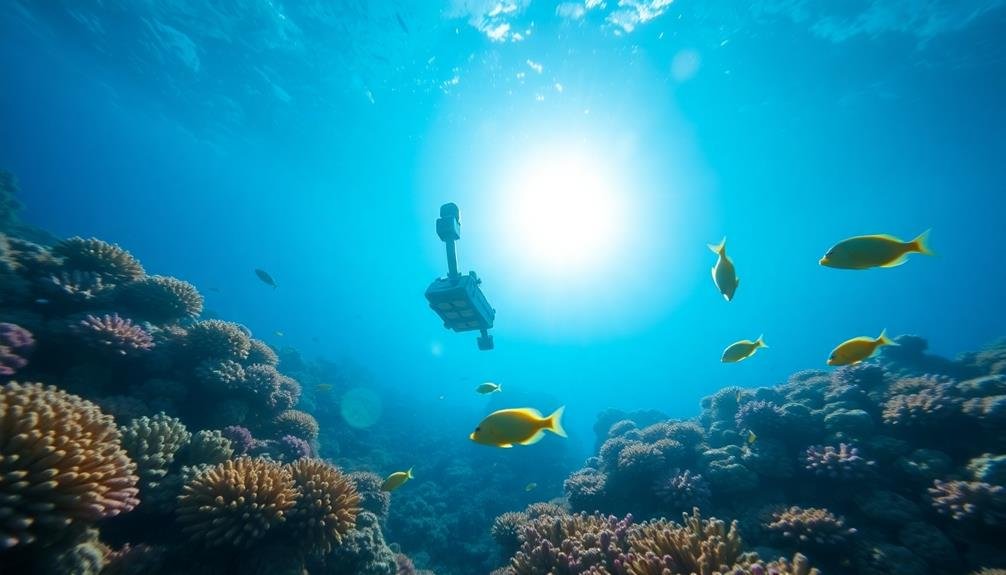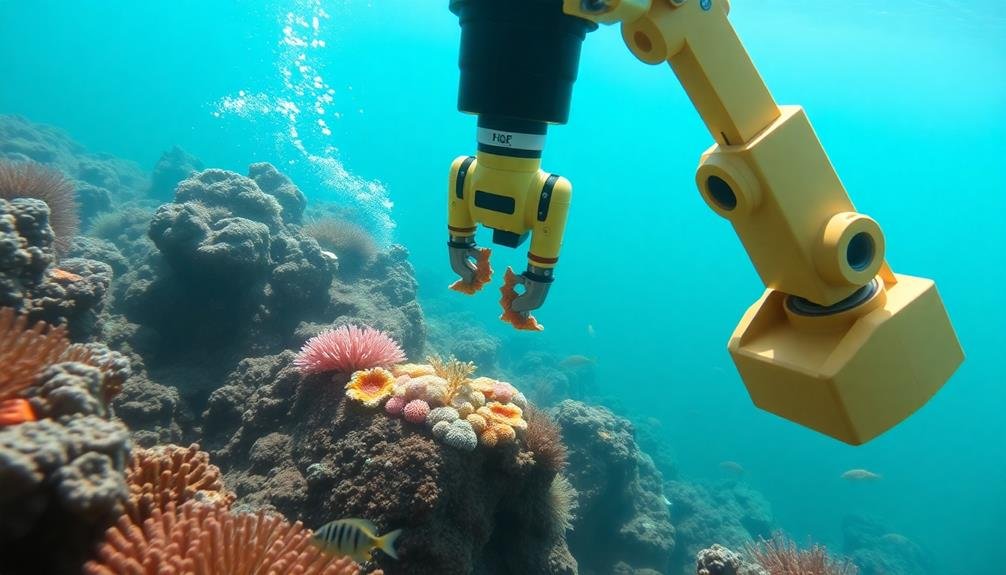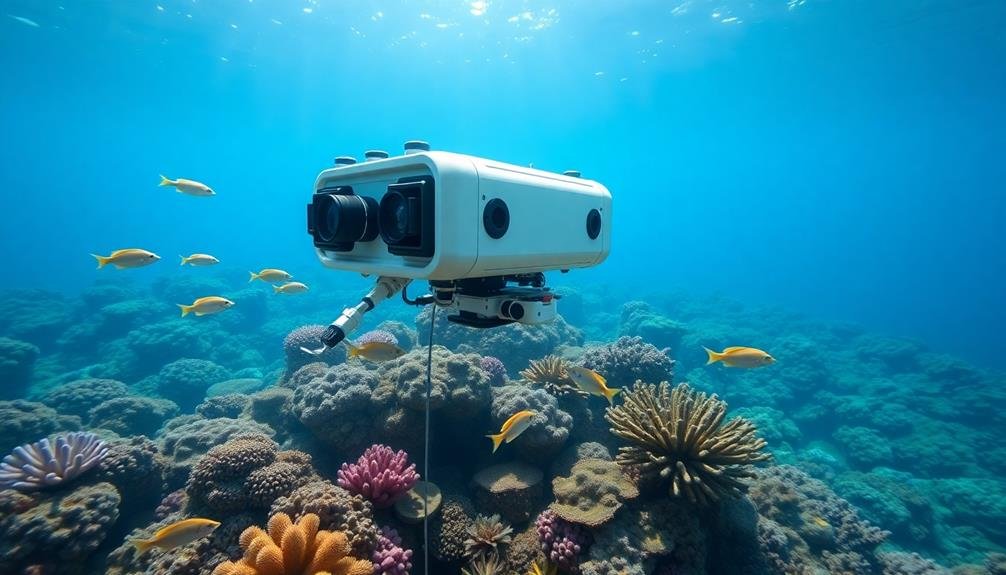Underwater robots are transforming coral reef research, offering unprecedented insights into these essential ecosystems. They're mapping vast reef areas in 3D, evaluating reef health remotely, and tracking coral bleaching events with precision. These high-tech explorers are discovering new coral species, especially in deep-sea environments, and monitoring marine biodiversity changes over time. They're also playing a significant role in coral reef restoration efforts and detecting climate change impacts. With advanced sensors and imaging capabilities, underwater robots are revealing hidden habitats, documenting rare species, and gathering important data on water quality. The future of coral research looks increasingly robotic and data-driven.
Underwater Robots in Coral Research

In recent years, underwater robots have revolutionized coral reef research. These sophisticated machines allow scientists to explore deeper, longer, and more efficiently than ever before. You'll find that these robots come in various forms, from autonomous underwater vehicles (AUVs) to remotely operated vehicles (ROVs).
These robots are equipped with high-resolution cameras, sensors, and sampling tools that enable researchers to collect data with unprecedented precision. They can map vast areas of coral reefs, monitor water quality, and even take microscopic images of coral polyps.
You'll be amazed at how these robots can operate in challenging conditions where human divers can't safely venture.
One of the most significant advantages of using underwater robots is their ability to conduct long-term monitoring. They can stay submerged for extended periods, providing continuous data on coral health, growth rates, and environmental changes.
This information is essential for understanding the impacts of climate change and other stressors on coral ecosystems.
As technology advances, you'll see these robots becoming even more sophisticated, potentially leading to groundbreaking discoveries in coral reef science and conservation efforts.
Mapping Coral Reef Ecosystems

Immerse yourself in the world of coral reef mapping, where underwater robots are transforming our understanding of these complex ecosystems. These high-tech machines are revolutionizing the way we survey and document coral reefs, providing unprecedented detail and coverage.
You'll find that underwater robots, equipped with advanced sensors and cameras, can create 3D maps of reef structures with remarkable accuracy. They're able to cover vast areas quickly, capturing data on coral distribution, species diversity, and reef health.
These robots don't just map the surface; they can also penetrate deeper into reef crevices and caves, revealing hidden habitats and organisms.
As you explore this technology, you'll discover that it's not just about creating pretty pictures. The data collected by these robots is essential for monitoring reef changes over time, identifying areas at risk, and guiding conservation efforts.
Scientists are using these detailed maps to track coral bleaching events, assess damage from storms or human activities, and even plan reef restoration projects. With underwater robots, we're gaining a more thorough view of coral reef ecosystems than ever before, helping us better protect these critical marine habitats.
Assessing Reef Health Remotely

Beyond mapping, underwater robots are revolutionizing how we assess coral reef health from afar. These machines can now gather data on various indicators of reef wellness without human divers present. You'll find robots equipped with high-resolution cameras and sensors that measure water temperature, pH levels, and dissolved oxygen content.
Some robots use advanced imaging techniques like fluorescence and multispectral analysis to detect early signs of coral bleaching or disease. They can spot changes in coral color or texture that might be invisible to the naked eye. This allows researchers to intervene quickly when problems arise.
Here's a breakdown of key assessment methods:
| Method | Data Collected | Application |
|---|---|---|
| Thermal Imaging | Temperature variations | Detect bleaching hotspots |
| Chemical Sensors | pH, oxygen levels | Monitor water quality |
| 3D Scanning | Reef structure changes | Track growth or erosion |
These remote assessments help scientists monitor vast reef areas more efficiently than ever before. By combining data from multiple robots, you can create a thorough picture of reef health across entire ecosystems. This information is essential for developing effective conservation strategies and predicting how reefs might respond to future climate changes.
Tracking Coral Bleaching Events

You'll find underwater robots invaluable for tracking coral bleaching events through extensive mapping of affected areas.
These robotic systems can cover large swaths of reef, efficiently documenting the extent and severity of bleaching.
Additionally, you can equip them with sensors for real-time temperature monitoring, providing essential data to understand and predict bleaching occurrences.
Mapping Bleaching Extent
Underwater robots have revolutionized our ability to track and map coral bleaching events. These autonomous vehicles can cover vast areas of reef systems, providing researchers with extensive data on the extent of bleaching.
You'll find that these robots use high-resolution cameras and advanced imaging techniques to capture detailed images of coral colonies. They're equipped with sensors that measure water temperature, salinity, and light levels, all factors that contribute to bleaching.
As the robots navigate the reefs, they create 3D maps that show the distribution and severity of bleached corals. The data collected by these underwater robots allows scientists to quantify the percentage of affected corals in a given area.
You can see how this information is essential for understanding the scale of bleaching events and their impact on reef ecosystems. Researchers use this data to identify patterns and hotspots of bleaching, helping them predict future events and prioritize conservation efforts.
Real-Time Temperature Monitoring
Building on the mapping capabilities of underwater robots, real-time temperature monitoring has become a key component in tracking coral bleaching events. These robots are equipped with advanced sensors that continuously measure water temperature around coral reefs.
You'll find that this data is vital for identifying potential bleaching hotspots before visible signs appear. The robots transmit temperature readings to researchers in real-time, allowing for rapid response to temperature spikes. This immediate feedback enables scientists to deploy additional resources or implement protective measures quickly.
You can see how this proactive approach helps mitigate the impact of bleaching events on coral ecosystems. Moreover, these underwater robots can monitor temperature variations at different depths and locations within a reef system.
This detailed information provides an extensive view of temperature patterns, helping researchers understand how heat stress affects various coral species. You'll appreciate how this data contributes to developing more accurate predictive models for future bleaching events.
Identifying New Coral Species

You'll find that underwater robots are revolutionizing the discovery of new coral species, especially in deep-sea environments.
These robotic explorers can capture high-resolution images and collect samples from rare, hard-to-reach coral formations.
Advanced imaging techniques allow scientists to analyze coral structures in unprecedented detail, leading to the identification of previously unknown species.
Rare Deep-Sea Corals
Scientists are diving deep into the mysteries of the ocean with underwater robots, uncovering rare and previously unknown coral species. These deep-sea corals thrive in environments that are often too extreme for human divers to explore. You'll find them in the dark, cold waters of the deep ocean, where they form intricate ecosystems that support a diverse array of marine life.
Underwater robots, equipped with high-resolution cameras and sampling tools, are revealing the beauty and complexity of these rare coral species. They're discovering corals that can glow in the dark, grow to enormous sizes, and survive in harsh conditions.
You might be surprised to learn that some deep-sea corals are among the oldest living organisms on Earth, with individual colonies lasting for thousands of years.
These robotic explorers are also helping scientists understand the threats facing deep-sea corals, such as ocean acidification and deep-sea mining. By studying these rare species, you're gaining insights into the resilience of marine ecosystems and the potential impacts of climate change on our oceans.
The discoveries made by underwater robots are vital for conservation efforts and may even lead to breakthroughs in medicine and biotechnology.
Robotic Imaging Techniques
Underwater robots are revolutionizing the way we identify new coral species through advanced imaging techniques. These sophisticated machines use high-resolution cameras and 3D mapping technology to capture detailed images of coral reefs in hard-to-reach areas.
You'll find that these robots can operate at depths and for durations that human divers can't match, allowing for extensive documentation of previously unexplored marine environments.
The imaging techniques employed by these robots include photogrammetry, which creates 3D models of coral structures, and fluorescence imaging, which helps identify unique pigments in corals.
You can see how these methods provide researchers with unprecedented views of coral morphology and behavior. The robots' ability to collect large datasets quickly and efficiently has led to the discovery of numerous new coral species.
Moreover, you'll notice that robotic imaging techniques allow for non-invasive study of coral reefs, minimizing damage to these fragile ecosystems.
Monitoring Marine Biodiversity

One of the most essential applications of underwater robots is monitoring marine biodiversity. These robots can efficiently survey large areas of coral reefs, collecting data on species abundance, distribution, and behavior. You'll find that they're particularly useful for tracking rare or elusive species that are difficult to observe through traditional methods.
Underwater robots equipped with advanced sensors can measure water quality parameters, such as temperature, pH, and dissolved oxygen levels. This information is vital for understanding how environmental changes affect marine life. They can also detect early signs of coral bleaching or disease outbreaks, allowing researchers to respond quickly to potential threats.
These robotic systems often use machine learning algorithms to identify and classify different species automatically. This capability considerably speeds up the process of biodiversity assessment and reduces human error.
Additionally, underwater robots can operate in deep or dangerous waters where human divers can't easily reach, providing valuable insights into previously unexplored ecosystems.
Coral Reef Restoration Efforts

Through innovative technology, coral reef restoration efforts have gained significant momentum. Underwater robots play an essential role in these initiatives, offering precision and efficiency in coral planting and monitoring. You'll find that these robotic helpers can navigate complex reef structures, carefully placing coral fragments in ideal locations for growth.
These machines aren't just planting corals; they're also assisting in the creation of artificial reef structures. Using 3D printing technology, robots can construct intricate reef frameworks that mimic natural formations, providing a stable base for coral growth. You'll be amazed at how quickly these artificial reefs can attract marine life and promote ecosystem recovery.
Robots are also invaluable in monitoring the success of restoration efforts. They can collect data on coral growth rates, water quality, and the presence of invasive species. This information helps scientists refine their restoration techniques and adapt to changing environmental conditions.
In areas affected by coral bleaching, robots equipped with heat-resistant coral species can help repopulate damaged reefs. You'll see these mechanical assistants working tirelessly to give our coral reefs a fighting chance against the threats of climate change and human impact.
Climate Change Impact Detection

Climate change's fingerprints are becoming increasingly visible on coral reefs, and underwater robots are at the forefront of detecting these impacts. These high-tech machines are equipped with advanced sensors and cameras, allowing them to monitor and measure various environmental parameters that indicate climate-related stress on coral ecosystems.
You'll find underwater robots collecting data on water temperature, acidity levels, and dissolved oxygen content. They're also capturing high-resolution images and video footage to document coral bleaching events, disease outbreaks, and changes in reef structure. This wealth of information helps scientists track the progression of climate change impacts over time and across different reef systems.
Here's a breakdown of how underwater robots are contributing to climate change impact detection on coral reefs:
| Parameter | Measurement Method | Significance |
|---|---|---|
| Temperature | Thermal sensors | Indicates potential bleaching events |
| pH levels | Chemical sensors | Monitors ocean acidification |
| Dissolved oxygen | Optical sensors | Assesses water quality and stress levels |
| Coral cover | Image analysis | Tracks changes in reef composition |
| Species diversity | AI-powered recognition | Identifies shifts in ecosystem balance |
Future of Underwater Robotics

Advancing at a rapid pace, underwater robotics is poised to revolutionize coral reef research and conservation efforts. You'll see more sophisticated autonomous underwater vehicles (AUVs) capable of longer missions and deeper dives. These robots will feature improved sensors, AI-driven decision-making, and enhanced data processing capabilities.
Future underwater robots will likely incorporate swarm technology, allowing multiple units to work together seamlessly. They'll be able to cover larger areas more efficiently and respond to dynamic environmental changes in real-time.
You can expect to see robots equipped with advanced imaging systems, including 3D mapping and hyperspectral cameras, providing unprecedented detail of reef structures and health.
As battery technology improves, you'll witness extended mission durations and reduced environmental impact. Robots will also become more versatile, with modular designs allowing for easy customization based on specific research needs.
They'll play a vital role in reef restoration efforts, assisting in tasks like coral transplantation and monitoring regrowth. With ongoing advancements, underwater robotics will continue to be an invaluable tool in understanding, protecting, and preserving coral reef ecosystems for future generations.
Frequently Asked Questions
How Deep Can Underwater Robots Dive to Study Coral Reefs?
You'll find underwater robots can plunge incredibly deep to study coral reefs. They're capable of reaching depths up to 20,000 feet, far beyond human diving limits. This allows them to explore and research even the deepest reef ecosystems.
What Power Sources Do Underwater Robots Use for Extended Missions?
You'll find that underwater robots often use rechargeable lithium-ion batteries for power. They'll also employ solar panels, fuel cells, or even wave energy converters for extended missions. Some advanced models can even recharge at underwater docking stations.
Can Underwater Robots Communicate With Each Other During Coral Reef Exploration?
Yes, underwater robots can communicate with each other during coral reef exploration. They'll use acoustic signals, optical links, or radio waves to share data, coordinate movements, and collaborate on tasks. You'll see them working together efficiently underwater.
How Do Researchers Prevent Underwater Robots From Damaging Delicate Coral Ecosystems?
You'll find researchers use several methods to protect coral. They'll equip robots with sensors to detect obstacles, program specific movement patterns, and employ soft materials for robot bodies. They'll also limit robot size and carefully plan exploration routes.
Are There Any Risks to Marine Life From Underwater Robots' Presence?
You'll find that underwater robots can pose some risks to marine life. They might disturb habitats, create noise pollution, or collide with animals. There's also a chance they could introduce foreign substances or microorganisms into delicate ecosystems.
In Summary
You've seen how underwater robots are revolutionizing coral reef research. They're mapping vast ecosystems, evaluating health remotely, and tracking bleaching events. These high-tech helpers are discovering new species, monitoring biodiversity, and aiding restoration efforts. They're also essential in detecting climate change impacts. As technology advances, you can expect even more sophisticated robots to dive deeper into the mysteries of our coral reefs, providing critical data for their protection and preservation.

As educators and advocates for responsible drone use, we’re committed to sharing our knowledge and expertise with aspiring aerial photographers.




Leave a Reply